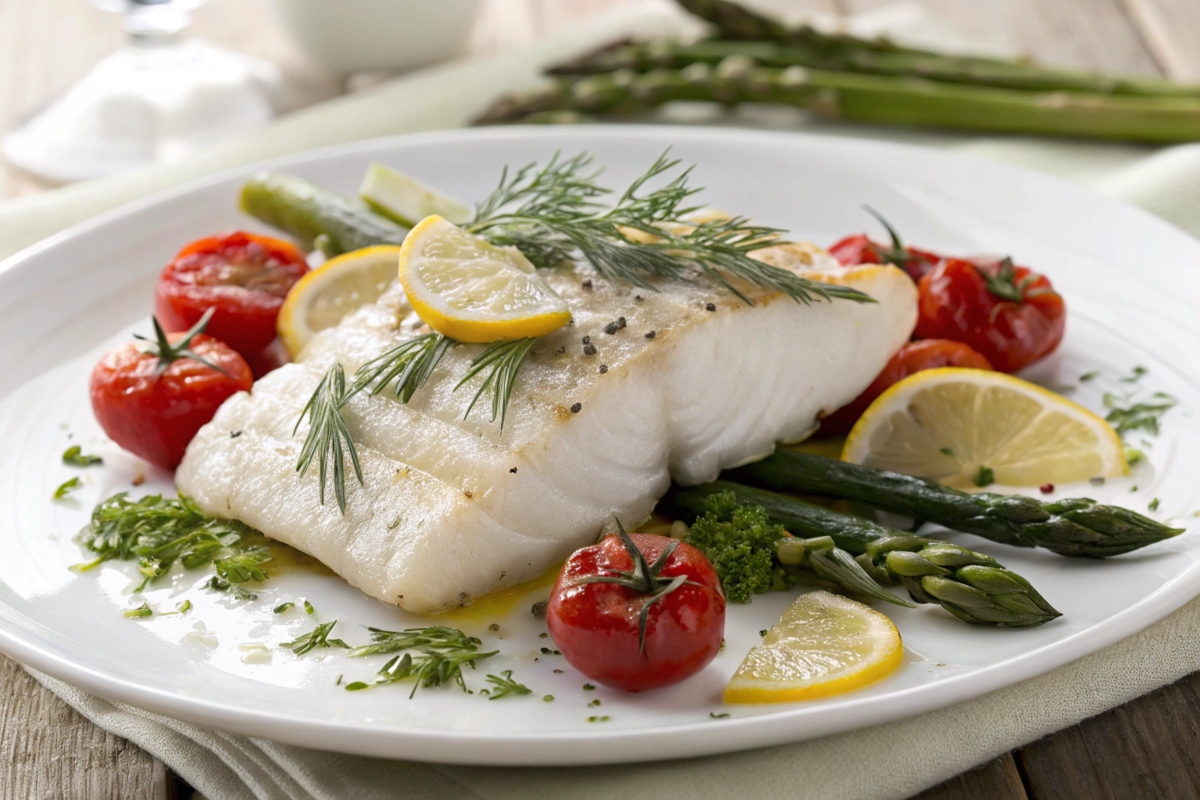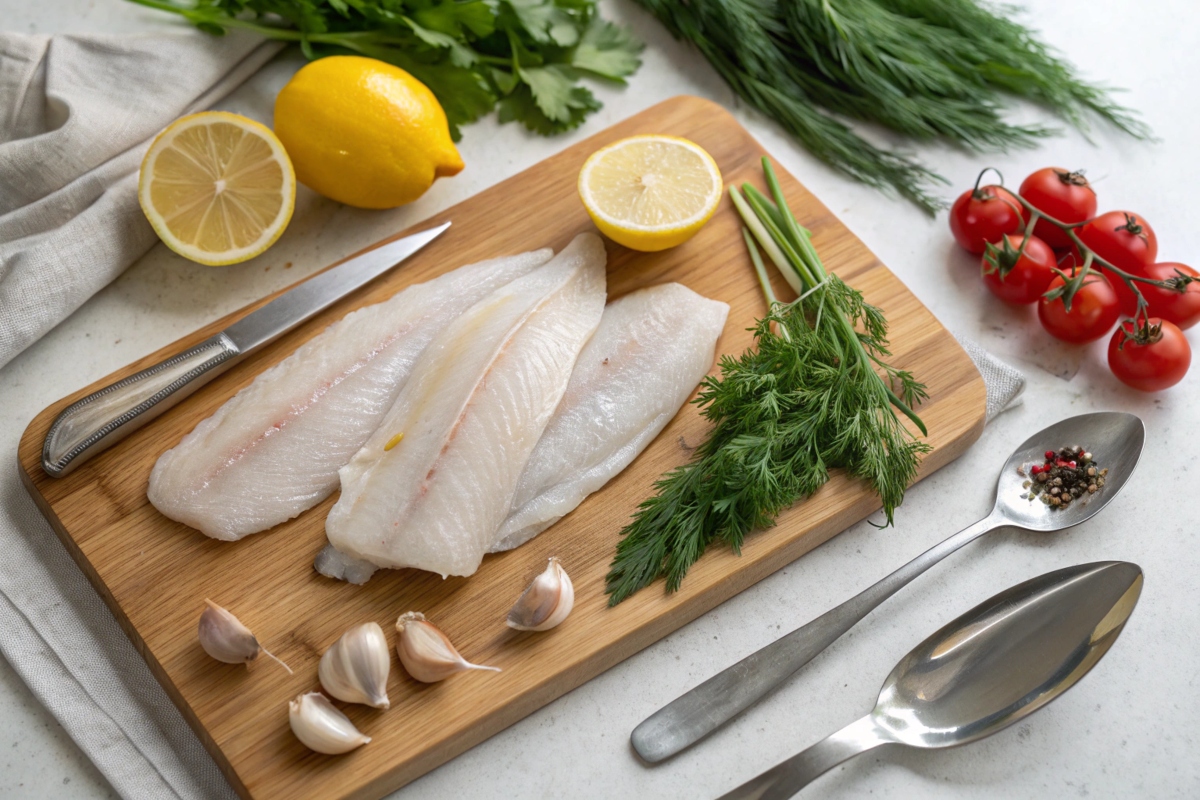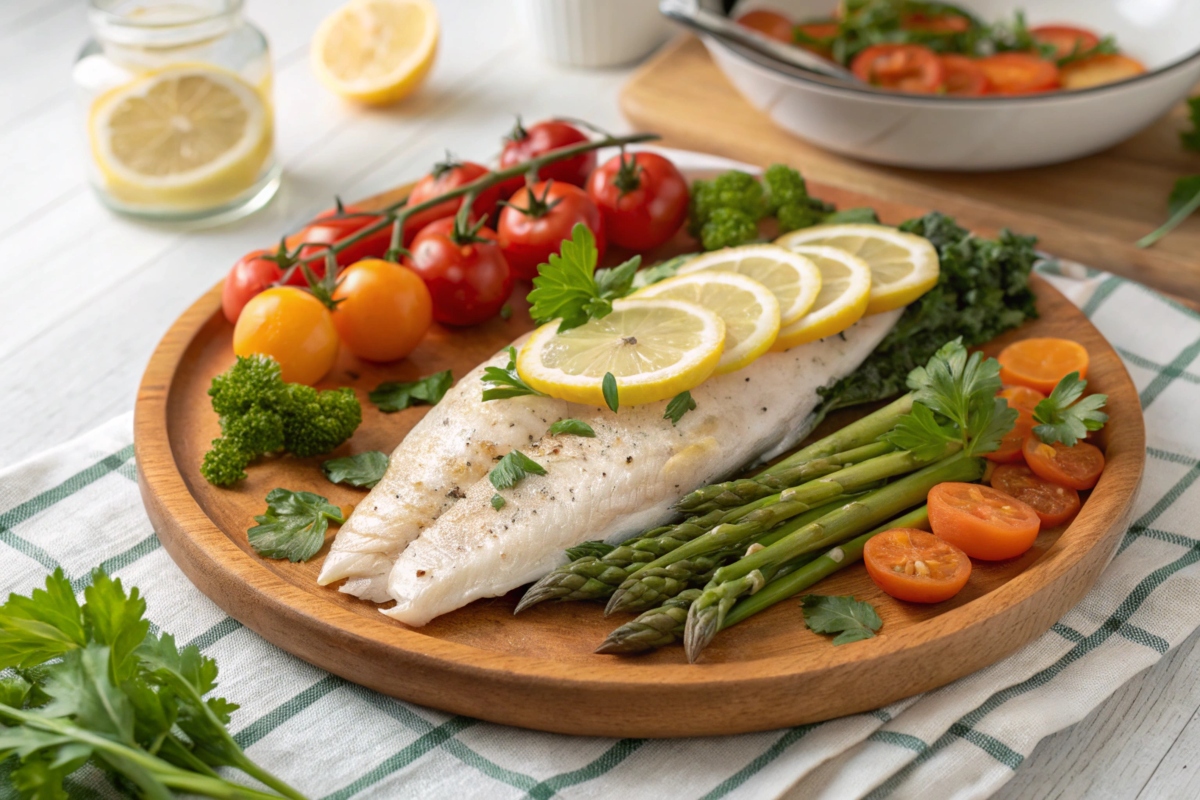White fish recipes healthy options are perfect for anyone looking to enjoy a flavorful yet nutritious meal. Packed with lean protein and essential nutrients, these recipes make healthy eating effortless and enjoyable.
In this article, we will explore the benefits, uses, and common myths surrounding white fish, helping you understand why it deserves a place on your plate. Whether you are trying to explore healthier food options or simply looking for new recipes, white fish has something to offer everyone. Moreover, it is easy to prepare, widely available, and suitable for various cooking styles.
By the end of this guide, you’ll see how this humble protein can transform your meals and improve your health. So, keep reading, as we dive into why white fish is a must-have addition to your diet and your kitchen.
Health Benefits of White Fish Recipes Healthy
Low in Fat and Calories
White fish are naturally lean, containing very little fat. This makes them ideal for:
- Weight Management: Their low calorie and fat content support calorie-controlled diets.
- Heart Health: Unlike fatty meats, white fish have negligible saturated fats, which may help maintain healthy cholesterol levels.
Examples: Cod, haddock, and tilapia are particularly low-fat options.
Rich Source of High-Quality Protein
White fish are an excellent source of lean protein, which is essential for:
- Muscle Growth and Repair: Protein supports muscle building and recovery, making white fish great for active individuals and athletes.
- Satiety: High protein content helps you feel full longer, reducing the likelihood of overeating.
- Tissue Repair: Supports cell repair and overall body maintenance.
Packed with Essential Vitamins
White fish are rich in several vitamins that are crucial for health, including:
- Vitamin B12: Important for red blood cell production, nerve health, and DNA synthesis.
- Vitamin D (in certain species): Helps with calcium absorption, supporting bone health and immune function.
- Vitamin B6: Aids brain development and function, as well as energy metabolism.
Rich in Minerals
White fish provide key minerals necessary for various bodily functions:
- Selenium: A powerful antioxidant that protects cells from damage and supports thyroid function.
- Phosphorus: Essential for strong bones and teeth.
- Potassium: Helps regulate blood pressure and maintain proper fluid balance.
Heart Health Benefits
- White fish are low in saturated fat and provide moderate amounts of omega-3 fatty acids, particularly in species like halibut and pollock. Omega-3s support:
- Healthy Cholesterol Levels: Reduce bad cholesterol (LDL) and improve good cholesterol (HDL).
- Reduced Inflammation: Protect against cardiovascular diseases and support overall heart health.
Supports Brain Health
The omega-3s found in some white fish (though less than in oily fish) contribute to:
- Cognitive Function: Support brain health and reduce the risk of cognitive decline.
- Mood Regulation: Omega-3s have been linked to improved mood and lower risks of depression.
Improved Digestive Health
White fish are light and easy to digest, making them suitable for individuals with sensitive stomachs or digestive issues. They are a great protein source for people recovering from illness or on restricted diets.
Low Mercury Levels
Compared to some other fish, many white fish species like tilapia and cod have lower mercury levels. This makes them a safer option, especially for:
- Pregnant women
- Children
- Individuals concerned about mercury exposure
Supports Bone Health
The phosphorus and vitamin D content in white fish contribute to:
- Bone Strength: These nutrients are essential for maintaining strong bones and preventing conditions like osteoporosis.
- Teeth Health: Promotes strong teeth by supporting enamel and jawbone integrity.
Versatile and Accessible
White fish are easy to include in a healthy diet due to their versatility. They can be:
- Grilled, baked, poached, or steamed without the need for heavy oils or creams.
- Paired with vegetables, whole grains, and light sauces for a balanced meal.
Who Can Benefit Most from White Fish?
- Athletes and Gym-Goers: For muscle repair and recovery due to high protein content.
- Weight Watchers: For low-calorie, satisfying meals.
- Heart-Conscious Individuals: To maintain cardiovascular health.
- Pregnant Women: For essential nutrients without high mercury risks.
White Fish Recipes Healthy is not only delicious but also incredibly nutritious. Its health benefits make it a great addition to any diet, supporting overall wellness, heart health, and weight management. For those exploring creative options, the lemon pepper fish recipe is a flavorful choice that perfectly balances zest and spice.
Basic Ingredients for Cooking White Fish Recipes Healthy
- White Fish Fillet
- Popular choices include cod, haddock, tilapia, halibut, or snapper. Fresh or frozen works well, depending on availability.
- Salt and Pepper
- Basic seasonings to enhance the natural flavors of the fish.
- Olive Oil or Butter
- Used for grilling, pan-searing, or baking to add richness and prevent sticking.
- Lemon or Lime Juice
- Provides a tangy, fresh flavor and balances the richness of the fish.
- Garlic
- Freshly minced or powdered garlic adds depth and aromatic flavor.
- Herbs
- Fresh or dried herbs like parsley, dill, thyme, or cilantro complement white fish beautifully.
- Spices
- Paprika, cumin, cayenne pepper, or black pepper for added flavor.
- Breadcrumbs or Flour
- Used for coating if frying or baking to create a crispy texture.
- Vegetables (Optional)
- Ingredients like cherry tomatoes, bell peppers, or zucchini pair well when baking white fish.
- White Wine (Optional)
- Adds a subtle depth of flavor in sauces or when baking.
Additional Ingredients for White Fish Recipes Healthy:
- Cream or Coconut Milk: For creamy sauces or curries.
- Soy Sauce or Fish Sauce: Common in Asian-inspired dishes.
- Capers or Olives: For Mediterranean recipes.
- Chili Flakes or Peppers: To add a spicy kick.
- Cheese (like Parmesan): For crusted or baked white fish dishes.
Feel free to customize these ingredients based on the specific recipe you’re preparing! Would you like a detailed recipe for any particular white fish dish?
Cooking Techniques for White Fish Recipes Healthy
Cooking white fish can be both simple and rewarding. Its mild taste pairs well with various seasonings, allowing you to experiment with different flavors. Choosing the right cooking method ensures you preserve its nutrients and texture.
Popular techniques include:
- Grilling
Grilled white fish recipes are healthy and quick to prepare, requiring minimal oil while retaining the fish’s natural flavors. - Baking
Baking is another excellent method for crafting white fish recipes healthy dishes, as it locks in moisture and nutrients without adding extra fat. - Steaming: Retains nutrients and keeps the fish tender without added fats.
- Frying: While delicious, frying white fish adds calories, so it’s best enjoyed occasionally.
When cooking white fish, use fresh herbs, citrus, and light marinades to elevate its taste. Avoid overcooking, as this can make the fish dry and unappetizing. For best results, choose high-quality white fish varieties like cod, haddock, or tilapia. These options are not only affordable but also versatile for any recipe.
White Fish Recipes Healthy in Diets:
White fish plays a significant role in various diets, thanks to its low-calorie and nutrient-rich profile. Whether you follow a Mediterranean, keto, or paleo diet, white fish can fit seamlessly into your meal plans.
Why it’s a great dietary choice:
- Low-carb diets: White fish contains minimal carbohydrates, making it suitable for ketogenic meals.
- Weight loss diets: Its high protein content keeps you full longer, reducing overall calorie intake.
- Heart-healthy diets: Packed with omega-3s, white fish supports cardiovascular health.
In addition, white fish is often recommended for detox plans due to its light and digestible nature. Pair it with leafy greens, quinoa, or roasted vegetables for a balanced meal. The adaptability of white fish ensures it can meet the needs of diverse dietary preferences without compromising flavor or nutrition.
Key Characteristics White Fish Recipes Healthy:
- Mild Flavor: The taste of white fish is subtle, allowing them to easily absorb seasonings and sauces, making them suitable for a wide variety of recipes.
- White Flesh: The flesh is usually firm yet tender, with a clean appearance that cooks to an opaque white.
- Flaky Texture: When cooked, the meat becomes flaky, adding a delicate texture to dishes.
Nutritional Profile White Fish Recipes Healthy:
- Low Fat Content: Unlike oily fish (e.g., salmon, mackerel, and sardines), white fish have minimal fat content, making them ideal for low-calorie diets.
- Rich in Protein: They are an excellent source of high-quality protein, which is essential for muscle repair and overall health.
- Micronutrients: White fish contain vital nutrients like selenium, vitamin B12, and phosphorus, which support energy production and bone health.
Common Uses in Cooking White Fish Recipes Healthy:
White fish are incredibly versatile and feature in many cuisines around the world. They can be:
- Grilled: This is one of the best White Fish Recipes Healthy dishes. It’s light, flavorful, and quick to prepare. Pair it with steamed vegetables for a complete meal.
- Baked: A classic among White Fish Recipes Healthy dishes, this recipe combines simplicity with bold flavors. Lemon and garlic enhance the taste while keeping it nutritious.
- Fried: Used in traditional dishes like fish and chips.
- Steamed or Poached: Perfect for preserving their delicate taste and nutritional value.
- Soups and Stews: Warm up with this hearty soup that’s a staple in many White Fish Recipes Healthy meal plans. Add fresh herbs for an extra touch of flavor.
Comparisons to Oily Fish:
White fish differ significantly from oily fish like salmon, tuna, and mackerel. While oily fish are rich in omega-3 fatty acids and have a stronger taste, white fish are prized for their light flavor and lower fat content. Both types, however, are nutritious and offer unique health benefits.
Popular Choices:
- Cod: A classic option, often used in fish tacos and baked dishes.
- Haddock: Commonly paired with chips or smoked for added flavor.
- Tilapia: A budget-friendly and versatile fish, ideal for everyday meals.
- Halibut: Known for its firm texture and suitability for grilling.
- Sole: A delicate fish, often cooked with butter and lemon for a refined taste.
White fish serve as an excellent base for countless recipes and are a staple in many diets due to their mild flavor and health benefits. For example, the classic combination of garlic and butter is elevated in this rockfish recipes guide, which offers unique twists on this timeless preparation.
Common Myths About White Fish Recipes Healthy
Despite its numerous benefits, several myths about white fish persist. Addressing these misconceptions can help you make informed dietary choices.
Common myths include in White Fish Recipes Healthy:
Myth 1: White fish lacks flavor.
On the contrary, its mild taste makes it an excellent blank canvas for bold seasonings and sauces, allowing you to create a wide variety of flavorful dishes. As a result, white fish can be just as enjoyable as other proteins when prepared with creativity.
Myth 2: Frozen white fish is inferior.
In reality, freezing helps preserve its nutrients and freshness when done correctly. Moreover, it allows for convenient storage, ensuring that you always have a healthy option on hand for your meals.
Myth 3: All white fish is the same.
In fact, varieties like cod, pollock, and halibut differ significantly in texture and taste. Therefore, they offer unique culinary experiences that can suit different recipes and preferences.
By understanding these facts, doubts about white fish can be dispelled, encouraging its inclusion in your meals. When prepared properly, white fish can be just as flavorful and satisfying as any other protein, making it a versatile addition to your diet.
White Fish for Kids
Introducing white fish into children’s diets is a smart way to ensure they receive vital nutrients. For example, its high protein and omega-3 content supports growth and cognitive development. Additionally, its mild flavor and tender texture make it more appealing to young palates compared to stronger-tasting seafood options. As a result, white fish becomes an easy and nutritious choice for parents looking to establish healthy eating habits for their kids.
Tips for serving White Fish Recipes Healthy to kids:
To begin with, make fish fingers using fresh white fish coated in whole-grain breadcrumbs for a healthier twist on a classic favorite. After that, consider incorporating white fish into pasta dishes with creamy sauces, which adds a hearty and delicious touch to your meal. Additionally, you can serve it alongside familiar sides like mashed potatoes or rice, which not only makes it comforting but also appealing to all age groups.
On top of its versatility, the high protein and omega-3 content in white fish plays a significant role in supporting children’s growth and cognitive development. What’s more, it is easy to digest, making it an excellent choice even for toddlers. By starting early, you can help set the stage for lifelong healthy eating habits. All in all, white fish is not just nutritious but also highly adaptable, making it a perfect choice for meals the entire family will enjoy. check out the lemon pepper fish recipe for inspiration.
Conclusion
White Fish Recipes Healthy its exceptional health benefits to its culinary versatility, white fish stands out as an invaluable addition to any diet. Not only is it packed with essential nutrients like protein, omega-3 fatty acids, and vitamins, but it also supports everything from muscle growth to heart health. Moreover, its mild flavor and adaptable nature make it a perfect choice for a wide range of recipes and dietary plans, catering even to the pickiest eaters.
By incorporating white fish recipes healthy options into your meal plan, you can enjoy delicious dishes while supporting your overall well-being. Start experimenting today with these easy-to-follow recipes. Check ou Fish Recipes
FAQs
What type of fish is white fish?
White fish is a term used to describe a variety of fish known for their mild flavor, white flesh, and flaky texture. Typically, these fish are lean and include species such as cod, haddock, tilapia, pollock, halibut, and sole. Unlike oily fish, such as salmon or mackerel, white fish are low in fat, making them a healthier option for those watching their fat intake. Additionally, their delicate taste and versatile nature make them a popular choice in a wide range of recipes. Whether you are preparing a simple weekday meal or an elegant dinner, white fish offers a reliable and adaptable option for your table.
What is the best white fish to eat?
The best white fish depends on your preferences and dietary needs, but these are popular choices:
- Cod: Mild, slightly sweet flavor, excellent for frying, baking, or broiling.
- Haddock: Slightly firmer than cod, often used in fish and chips.
- Halibut: A firmer option with a buttery flavor, ideal for grilling or roasting.
- Tilapia: Affordable and mild, making it great for those new to seafood.
- Sole: Delicate and tender, best prepared with light cooking methods like poaching.
What’s the cleanest fish to eat?
The cleanest fish are those with low mercury levels, caught using eco-friendly methods, and with little harm to the environment. Here are some of the best choices:
- Wild-caught Alaskan salmon: Rich in omega-3 fats and caught in a way that protects fish populations.
- Pacific cod: A mild-tasting fish with low mercury levels.
- Rainbow trout: Usually farmed in a safe and clean way, making it a good choice.
- Sardines: Small fish that don’t collect much mercury and are healthy to eat.




2 thoughts on “White Fish Recipes Healthy: Nutritious, Delicious & Easy to Make”